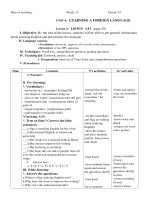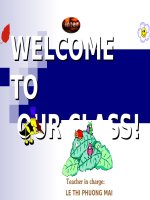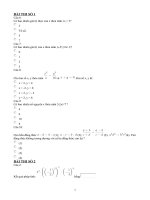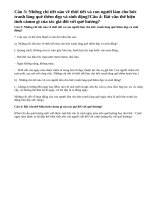Earths resources lesson 3 11 trang
Bạn đang xem bản rút gọn của tài liệu. Xem và tải ngay bản đầy đủ của tài liệu tại đây (3.18 MB, 11 trang )
Earth's
Resources
Lesson 3
Grade 6
CA Unit 6
w w w.harcour tschool.com
ISBN-13: 978-0-15-349213-6
ISBN-10: 0-15-349213-9
Ë|xHSKBPDy492136zv*:+:!:+:!
CXECA08ARD606_LLR_CVb.indd 2-3
>
2/20/06 4:49:49 PM
Think About the Reading
1. What can you do to help you remember what you have
learned?
2. What questions do you have after reading this book?
How can you find the answers to your questions?
Copyright © by Harcourt, Inc.
All rights reserved. No part of this publication may be reproduced or transmitted in
any form or by any means, electronic or mechanical, including photocopy, recording,
or any information storage and retrieval system, without permission in writing from the
publisher.
Requests for permission to make copies of any part of the work should be addressed to
School Permissions and Copyrights, Harcourt, Inc., 6277 Sea Harbor Drive, Orlando,
Florida 32887-6777. Fax: 407-345-2418.
HARCOURT and the Harcourt Logo are trademarks of Harcourt, Inc., registered in the
United States of America and/or other jurisdictions.
Hands-On Activity
Materials that are used to make many common items have a
natural orgin. In the following activities try to trace the natural
orgin of an item.
1. Make a list of three items in a car. What are these items
made out of?
2. Make a list of three item in your house. What are these
items made out of?
Printed in the United States of America
ISBN-13: 978-0-15-349213-6
ISBN-10: 0-15-349213-9
1 2 3 4 5 6 7 8 9 10
179
15 14 13 12 11 10 09 08 07 06
School-Home Connection
If you have received these materials as examination copies free of charge, Harcourt
School Publishers retains title to the materials and they may not be resold. Resale of
examination copies is strictly prohibited and is illegal.
Possession of this publication in print format does not entitle users to convert this
publication, or any portion of it, into electronic format.
CXECA08ARD606_LLR_CVb.indd 4-5
Find an everyday item that is made out of just one kind of
material with a family member. For example, classroom chalk
is made from the mineral gypsum. Once you locate your item,
write a paragraph together explaining what it is and what is the
natural origin of the material.
2/20/06 4:50:42 PM
Earth’ s
Resources
Lesson 3
Lesson 3
Where Do the Materials
You Use Come From?. . . . . . . . . . . . . . . . . . . . . .2
Visit The Learning Site!
www.harcourtschool.com
CXECA08ARD6063_BLR.indd 1
2/23/06 1:51:14 PM
3
VOCABULARY
synthetic
petroleum
product
Where Do
Materials
Come From?
Synthetic yarn is better for
people who are allergic to
natural fibers like wool.
2
CXECA08ARD6063_BLR.indd 2
2/20/06 4:17:45 PM
The fossil fuel petroleum is used to make many
materials. Anything that is made with petroleum
is called a petroleum product. Oil is one
petroleum product.
3
CXECA08ARD6063_BLR.indd 3
2/20/06 4:17:46 PM
READING FOCUS SKILL
MAIN IDEA AND DETAILS
The main idea is what the text is mostly about. Details are
pieces of information about the main idea.
Look for examples of materials that are used to build
structures and details about these materials.
Resources in Our Community
Think about the community you live in. What resources are used?
The building you live in probably uses wood. Wood is used for
construction and paper products.
We use other resources to build roads and foundations of
structures. Bricks and concrete are made from materials from Earth.
Asphalt is made from petroleum. Even metal is taken from Earth’s
crust through mining.
Metals and other natural materials must be processed in some
way. A tree goes through several steps before it can be used to build
a house.
Name a natural resource that is used in your community?
Wood is processed through
a lumber mill.
4
CXECA08ARD6063_BLR.indd 4
2/20/06 4:17:46 PM
Materials in Common
Most things that we use everyday are made from more than one
material. Jeans are made from many materials, starting with denim
fabric.
Most jeans are dyed blue. The dye is a synthetic. Something that
is synthetic is made from chemicals instead of natural materials.
Jeans also have zippers and buttons. These materials are usually
some type of metal. Brass, aluminum, and nickel can be used to
make zippers.
Items that you use every day are made up of many materials. A
pencil contains an eraser, brass holder, wood, paint and lead. These
come from very different sources, as you see in the picture.
What materials are used to make one pair of jeans?
Pencils are made from
several materials.
D Most pencil
shafts are
made from
cedar.
copper ore
A The lead in a pencil
is not lead at all. It is
a mixture of clay and
the mineral graphite.
zinc ore
5
CXECA08ARD6063_BLR.indd 5
2/20/06 4:17:51 PM
Petroleum Products
Petroleum is processed into oil and gasoline. Those fuels are
burned to heat homes, generate electricity, and run cars. Petroleum
can also be used to make materials. Asphalt, plastic, and paint are
made with petroleum. Petroleum products are goods that are
made with petroleum.
This family is displaying items
that are petroleum products.
6
CXECA08ARD6063_BLR.indd 6
2/23/06 4:56:08 PM
Many synthetic fibers, like nylon and polyester are petroleum
products. Many plastics, and paraffin wax used to make crayons are
petroleum products.
Cars need gasoline which comes from petroleum but there are
other petroleum products used in cars. Engine oil and antifreeze are
made with petroleum.
Name three objects that are made with petroleum.
Many items we use every
day, such as boots, are
made from petroleum.
Review
Fill in the blanks for this main idea statement.
1. Many of Earth’s natural ______ are used to make every
day materials and products.
Fill in the blank to complete each detail statement.
2. A ______ goes through several steps before it can be
used as lumber to build a home.
3. Something that is ______ is made from chemicals
rather than from natural materials.
4. Goods that are made with petroleum are called
______ ______ .
7
CXECA08ARD6063_BLR.indd 7
2/20/06 4:18:28 PM
GLOSSARY
petroleum product [puh•TROH•lee•uhm PRAHD•uhkt] Anything
made from the fossil fuel petroleum.
synthetic [sin•THET•ik] Something made from human-made
chemicals.
8
CXECA08ARD6063_BLR.indd 8
2/20/06 4:18:31 PM
Think About the Reading
1. What can you do to help you remember what you have
learned?
2. What questions do you have after reading this book?
How can you find the answers to your questions?
Copyright © by Harcourt, Inc.
All rights reserved. No part of this publication may be reproduced or transmitted in
any form or by any means, electronic or mechanical, including photocopy, recording,
or any information storage and retrieval system, without permission in writing from the
publisher.
Requests for permission to make copies of any part of the work should be addressed to
School Permissions and Copyrights, Harcourt, Inc., 6277 Sea Harbor Drive, Orlando,
Florida 32887-6777. Fax: 407-345-2418.
HARCOURT and the Harcourt Logo are trademarks of Harcourt, Inc., registered in the
United States of America and/or other jurisdictions.
Hands-On Activity
Materials that are used to make many common items have a
natural orgin. In the following activities try to trace the natural
orgin of an item.
1. Make a list of three items in a car. What are these items
made out of?
2. Make a list of three item in your house. What are these
items made out of?
Printed in the United States of America
ISBN-13: 978-0-15-349213-6
ISBN-10: 0-15-349213-9
1 2 3 4 5 6 7 8 9 10
179
15 14 13 12 11 10 09 08 07 06
School-Home Connection
If you have received these materials as examination copies free of charge, Harcourt
School Publishers retains title to the materials and they may not be resold. Resale of
examination copies is strictly prohibited and is illegal.
Possession of this publication in print format does not entitle users to convert this
publication, or any portion of it, into electronic format.
CXECA08ARD606_LLR_CVb.indd 4-5
Find an everyday item that is made out of just one kind of
material with a family member. For example, classroom chalk
is made from the mineral gypsum. Once you locate your item,
write a paragraph together explaining what it is and what is the
natural origin of the material.
2/20/06 4:50:42 PM









